目次
Mt. Tsukuba, which is crowded with tourists
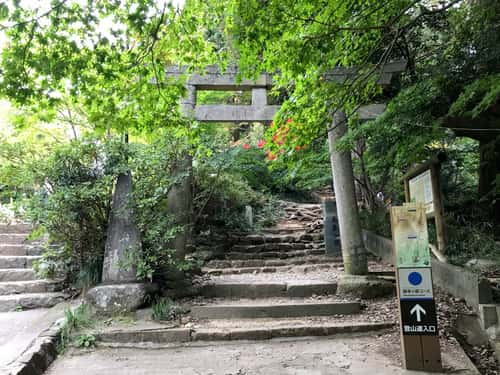
Entrance to the Mt. Tsukuba TrailThere is a saying in Japanese that says, “It’s dark under the lighthouse.” For some reason, I found myself looking at Mt. Tsukuba from my office window almost every day. Since I had never been up there before, I felt that I just had to climb it at least once. I thought that I could start the hike in the afternoon and return by 5:00 p.m. right when the sky is about to turn dark. The weather was cloudy, but warm and comfortable. I parked the car at Mt. Tsukuba Shrine, paid my respects at the shrine, and started climbing from the trail at a little after 12:40 pm.
Many visitors were at the shrine even though it was only Sunday, and I saw many people of all ages climbing the mountain, including many families with children. As I first headed towards Nantai-san, I hastened my steps, assuming the halfway point would only take 45 minutes since the sign said it takes 1.5 hours to climb the mountain via the Miyukigahara Course. The mountain path leading up from directly behind the shrine was fairly easy. It is well marked with many signs and maps. After less than 50 minutes, I arrived at Miyukigahara, just before reaching the summit of Nantai-san. A little light rain started to sprinkle and I soon decided to head for the summit of Nantai-san. After praying at the shrine, I quickly returned to Miyukigahara and went for a walk while ignoring the light rain!
The Sheer Amount of Megaliths and Rare Stones were Impressive!
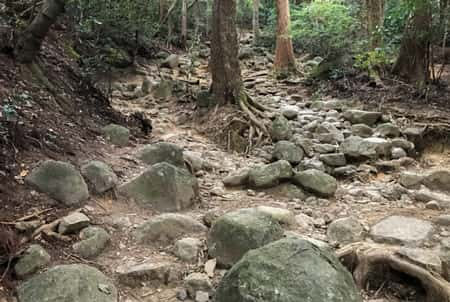
Rocky mountain path for climbing Mt. TsukubaThen, I saw a sign there that said, “Mt. Tsukuba Nature Study Path”, and after looking for the entrance, I finally found a path behind a small stand that had the Risshinseki, which was the most important megalith on Mt. Tsukuba. The rock is said to have been visited by a famous monk named Shinran Shonin, and the dynamic shape of the rock made my heart flutter. It is only 5 minutes away from Miyukigahara, but there was not a soul to be seen. Perhaps this rock is not well known or not popular, but I think more people should come and see the Risshinseki.
Then, after walking around the nature trail, I came back to the Miyukigahara stall. I looked for signs here and there, thinking that the trail could not be so short, but to my surprise, I found that the normal research trail was closed due to a slide down in the middle of the trail. I then found another entrance on the north side and decided to run there at once. On the way, I passed a mound made of pebbles with wishes on them, called “Ohshi Kasane,” which brought me back to the top of Nantai-san. In total, I ended up coming up to the peak of Nantaisan twice. Then, as soon as I started to descend, I found myself at the same stall that I had just left.
Miyukigahara was packed with people waiting for the cable car as far as I could see. From there, I rushed toward Nyotaisan, passing Sekirei-ishi and Gama-ishi on the way, and reached the summit of Nyotaisan in about 15 minutes. The rocky terrain here is more spectacular than that of Nantaisan. The view from the summit was also wonderful, and I was finally able to enjoy the panoramic view of Nyotaisan. The weather was a little sunny and the summit was full of people. Many people took the ropeway directly up from the foot of the mountain, so anyone could climb to the top.
Mt.Tsukuba, also known as the ‘Museum of Rocks’
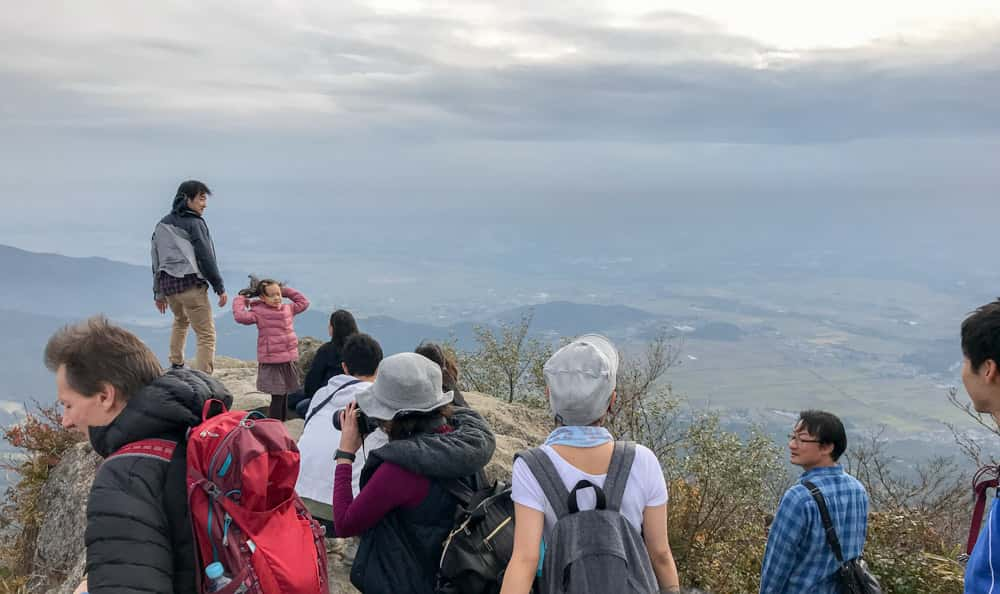
Crowds climbers Gathered at the Top of Nyotaisan
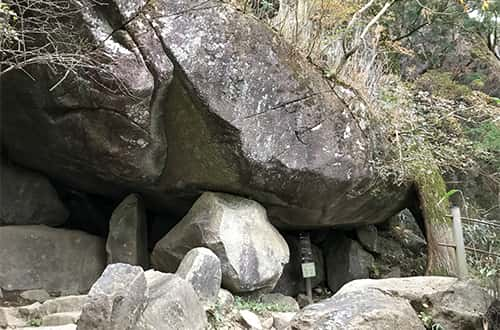 Mt.Tsukuba’s Famous Strange Rock Formations and the Passage through the Mother’s Womb.
Mt.Tsukuba’s Famous Strange Rock Formations and the Passage through the Mother’s Womb. 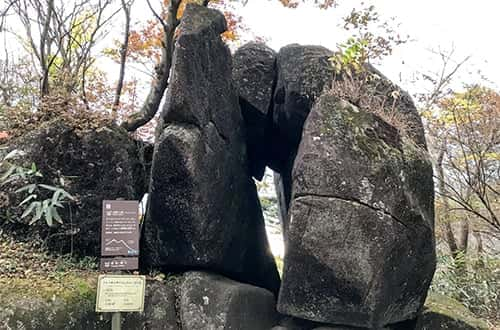 The Rock of Mt. Tsukuba Defune Irifune where the deity Funadama is enshrined
The Rock of Mt. Tsukuba Defune Irifune where the deity Funadama is enshrinedI walked around Nantaisan, Nyotaisan and the Research Route. Before I knew it, 1 hour and 45 minutes passed in the blink of an eye. I decided to go down the Hakuunbashi course, but the cliff was too steep for the first 200 meters, so I thought I had to go slowly because of the bad footholds. This is the best part of climbing (or descending?) Mt. Tsukuba. Starting from “Daibutsu Iwa” (Big Buddha Rock), I was impressed by many giant rocks called “Byobu Iwa,” “Hokuto Iwa,” “Uramen Daikoku,” “Debune Irifune”, “Yin-Yang Iwa”, and I enjoyed going down the mountain while stopping at places to take a closer look. At one strange rock formation called “Mother’s Womb Passage,” it is said that by passing through a gap in the rock formation, one can purify oneself from sins and impurities. Therefore, it is listed as one of the popular power spots. Immediately after that, there is a series of “Takamagahara” rock formations, and there is a narrow staircase between the rock formations. After reaching the top, there is a hall of worship where the gods are also enshrined. The last thing that is seen is a huge stone floating in the air, as if it were about to fall right onto the top of the mountain path. This is the rocky area known as “Benkei Nanamodori.
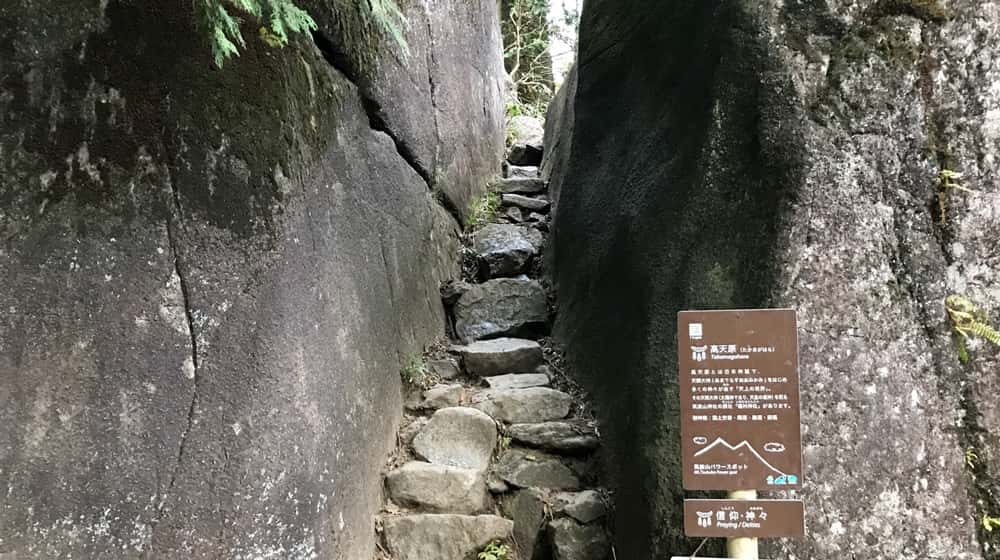
The Dwelling of Amaterasu on Mt. Tsukuba’s Takamagahara
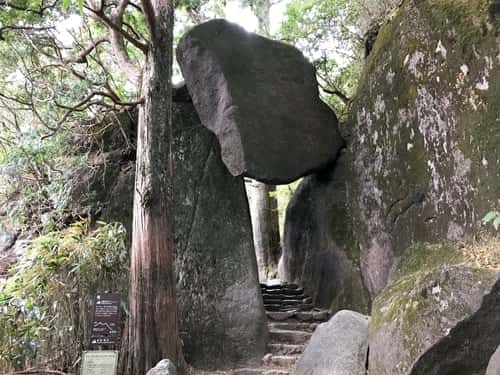
The Tsukuba Benkei Seven Returns, where a huge stone looks like it is about to fallWhile visiting Mt.Tsukuba, you will be amazed by the huge stones, which are no less than those on Gozaishodake and Rokko-san. On the last kilometer of the route, I had a pleasant walk back to the Mt. Tsukuba shrine with a woman from Fukushima (nicknamed Yama-girl), who had only been mountain climbing for one year and she was very fit. Mt. Tsukuba, also known as the Museum of Rocks, is a wonderful reizan that anyone can safely climb up and down. Anyone who wants to view the beautiful scenery of this mountain, meet a god, strengthen their legs and hips, and experience the beauty of nature, should take on the challenge of climbing the reizan Mount Tsukuba!
